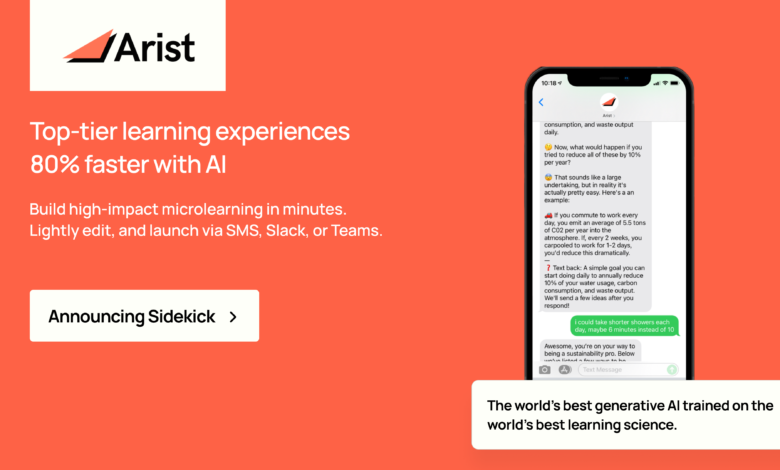
Through the pandemic and following economic irregularity, corporate learning has taken an increasingly prominent role in promoting organizational agility, keeping employee churn low, and filling skill gaps. Cumulatively there are trillions of dollars in efficiency gains to be had from effective corporate learning. This is not to mention the personal benefit to hundreds of millions of workers who primarily only gain training on the job throughout their careers.
But collectively, much of corporate learning has an issue getting relevant training out the door quickly enough. Corporate learning is costly and time-consuming to create. Latest benchmarks have shown that the average hour of corporate learning costs between 40 and 100 hours to produce. On top of this, even when learners receive their learning, there are barriers to adoption.
The first generative AI course builder lowers the time it takes for corporate learning to push out support for skill growth and organizational change exponentially. Coupled with delivery in messaging apps learners already use, adoption and learning what learning works and doesn’t dramatically improves.
How Arist Sidekick accelerates corporate learning creation by >80%
Traditionally, corporate training has relied on in-person instruction as well as longform (interactive or video-based) media for delivery. Arist is a microlearning tool that supports small moments of instruction, practice, or reflection embedded throughout a learners day.
Arist has focused on “shrinking” the smallest unit of learning, and accordingly delivers learning natively as messages within widely used messaging apps (MS Teams, Slack, SMS, WhatsApp).
Because lessons are largely text-based and smaller form factor, learning teams can already greatly reduce learning creation costs on the platform as well as iterate more quickly. The bite-sized nature of the learning is also appealing to learners, who are in the habit of responding to messages on popular messaging platforms and check them on average every six minutes.
As one of the few learning platforms primarily built around text content, Arist was uniquely positioned to accelerate course creation even further with recent advancements in text-generating AI.
Before Arist’s new AI product enhancement of Sidekick, learning teams already saved close to 80% on course creation costs by moving from in-person and multimedia-rich learning to small automatable messages. Sidekick accelerates this process even further by generating a draft of a course in minutes. Depending on the topic, the course may need some small level of editing. But early tests have shown a dramatic decrease in “time until live” for training.
Furthermore, Sidekick preserves the aspects of the microlearning platform most tied to reliable behavior change: Arist’s action-oriented learning model.
This learning model has been endorsed by research at UPenn and Stanford, and even used as a “digital vaccine” for misinformation by the World Health Organization. By ensuring lessons are created faster without sacrificing the scientific grounding for behavior change, learning teams can proceed with speed and confidence.
The future of the corporate learning tech stack
Corporate learning has historically relied on “pull” learning, that is learning where learners must seek out or choose learning (often from a large library). By its very nature, this learning occurs outside of the flow of work, often in another location or non-work app. This makes learning hard to attend, hard to immediately apply, and even hard to remember.
In contrast, push learning sends learning to learners. These learning moments are often smaller, and more convenient. Because they’re injected directly into work, the number of touch points with learners can grow exponentially. This means more data on what works and doesn’t, as well as more chances to test out new approaches. This sets the table for the next generation of machine learning and generative AI-powered corporate learning tools.
Text is better for generative AI, but can you learn via messages?
You can! In fact, it’s one of the most scientifically-backed corporate learning methods.
Corporate learning is primarily centered around reliably changing behavior to make individuals better at their jobs. The primary model used to explain effective behavior change — the Kirkpatrick Model — is broken into four stages:
- Reaction – did the learner find the learning engaging, relevant, and enjoyable
- Learning – did the learner retain information?
- Behavior – did the learning change behavior?
- Impact – did the learning impact organizational objectives?
Each level builds to the next. Without reaction, it’s hard to obtain learning. Without learning, it’s hard to obtain behavior change, and so forth.
For a variety of reasons, many corporate learning tools struggle with reaction. A bevy of stats support this, from average NPS scores for learning management systems (between -57 and 9 for major LMS’s), through the fact that it takes an average of 7 clicks to obtain learning in most learning tools (past three clicks, we naturally think a task is significantly more complex).
In contrast, messaging apps are used by 91% of the planet, and are checked by employees roughly every 6 minutes. They’re arguably the most accessible tech anywhere. And we’re hard wired to react when we get a message.
By shifting the location of learning to apps learners already love, learning teams are further along than they are with most delivery methods (AND it saves them a ton of time).
Of course there’s more under the hood that helps with other stages. But that’s more of a deep dive for another time. Care to learn more? Check out the Arist whitepaper here.






